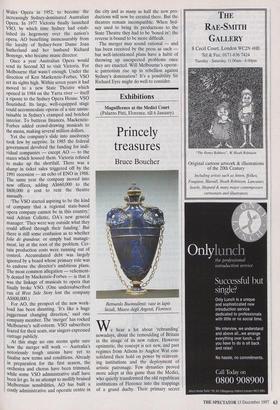Exhibitions
Magnificence at the Medici Court (Palazzo Pitti, Florence, till 6 January)
Princely treasures
Bruce Boucher
Bernardo Buontalenti: vase in lapis lazuli, Museo degli Argenti, Florence
We hear a lot about 'rebranding' nowadays, about the remoulding of Britain in the image of its new rulers. However optimistic, the concept is not new, and past regimes from Athens to Angkor Wat con- solidated their hold on power by reinvent- ing institutions and the deployment of artistic patronage. Few dynasties proved more adept at this game than the Medici, who quietly transformed the old republican institutions of Florence into the trappings of a grand duchy. Their primary secret weapon was Florentine art, and Magnifi- cence at the Medici Court, the sumptuous exhibition now at the Pitti Palace, cele- brates the first flush of Medici rule in the late-16th century.
The key to the exhibition lies in the word magnificence, a term associated with aris- tocratic largesse. Patronage was an exten- sion of social standing, and the newly established Medici dukes surrounded themselves with tapestries, state portraits, jewels, crystal bowls — in short all the paraphernalia of courtly life. The flavour of their world comes brilliantly to life in the Pitti Palace, largely because the look of the exhibition is given over to one of the great theatrical designers of today, Pier Luigi Pizzi. Better known for his opera produc- tions, Pizzi has turned increasingly to exhi- bitions in recent years, and with Magnificence at the Medici Court the fres- coed halls of the Pitti Palace have become the stage for a procession of spectacular objects. His staging cleverly mimics the ephemeral tableaux of late-Renaissance court entertainments, whipping up a fanta- sy architecture that maintains a dialogue with its setting throughout the exhibition. If anything, it is all too theatrical, for much of the sculpture is badly lit, and many of the smaller objects are too far away to be seen clearly. Despite this, the exhibition does underscore the importance of sculpture and the decorative arts in the hierarchy of art during the period.
Strangely enough, the greatest artists then active in Florence were foreign-born. The fleming Giambologna mastered the idiom of Michelangelo, adjusting it to the demands of formal elegance and state pro- paganda of the new court. Netherlandish goldsmiths like Jacques Bylivelt turned the designs of court artists into gold filigree reliefs and vases while northern weavers created the hangings which adorned the grand ducal apartments. The first two rooms in Palazzo Pitti establish the impor- tance of these arts by festooning a mock stage with full-scale works by Giambologna and his followers Giovanni Caccini and Pietro Francavilla. One of the great plea- sures here is to see the recently discovered Tata Morgana' by Giambologna presiding over an alcove similar to her original set- ting in a villa grotto. While the gods were pressed into service by the new regime, older sculptors like Baccio Badninelli and Benvenuto Cellini recast the unheroic grand dukes into their new role as heredi- tary rulers, a transformation especially evi- dent in Benvenuto Cellini's electrifying bronze bust of the founding father, Cosimo I, whose bull-like head glares down from a column of a neck.
Under Pizzi's design, each room at the Pitti is showered with fabulous works, like the treasury of a Renaissance prince. Ming vases and jade from Mexico is juxtaposed with Italian majolica; Milanese parade armour stands near Caravaggio's famous shield with the face of Medusa, a gift to Grand Duke Ferdinando I from the painter's Roman patron, Cardinal de' Monte. Bejewelled crowns lie next to gilt compasses and silvered dividers, for the Medici princes took a fashionable interest in practising as well as commissioning art. Best of all is the endless procession of vases of lapis lazuli embellished with gold and the great neffs and table centres of rock crystal so often glimpsed in contempo- rary paintings of feasts and festivals.
Magnificence of this nature was not sim- ply the product of mindless consumption. It also followed a strategy which saw the pro- duction of luxury goods as a major export for the grand ducal economy. Under Grand Duke Ferdinand I. work in hardstone grew into the fashionable Florentine pietra dura demanded by visitors on the Grand Tour. Early examples reflect a variety of uses from table tops and inlaid desks to elabo- rate scenes of chalcedony, lapis, gold, and mother of pearl; one of the most famous of those seen here sums up the exhibition; an oval mosaic in hardstone with a view of the Piazza della Signoria dominated by a gold- en overlay of GiamboIogna's great eques- trian monument to Cosimo I. The relief weaves together the techniques of gold- smiths' work, sculpture, and painterly per- spective to celebrate a palpably golden Medici rule.
The tour de force of the exhibition comes with a recreation of the tribuna, the octag- onal nucleus of the Uffizi galleries and original grand-ducal cabinet of curiosities. There are paintings by Vasari and his school as well as the bronze divinities by Giambologna and his collaborators from the studiolo in Palazzo Vecchio. Crowning it all is one of Raphael's greatest paintings, the 'Madonna della seggiola', probably made for an earlier Medici patron, Pope Leo X. Magnificence at the Medici Court overwhelms with sumptuousness, and the cumulative effect is impressive in showing how art can rebrand a regime.
'No Mum, we've decided to stay together because of the kids.



















































































 Previous page
Previous page